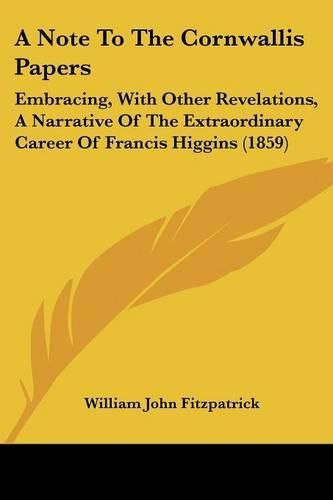Readings Newsletter
Become a Readings Member to make your shopping experience even easier.
Sign in or sign up for free!
You’re not far away from qualifying for FREE standard shipping within Australia
You’ve qualified for FREE standard shipping within Australia
The cart is loading…






Purchase of this book includes free trial access to www.million-books.com where you can read more than a million books for free. This is an OCR edition with typos. Excerpt from book: the reader, and the writer trusts that it may be found to form a singularly curious note to the History of Ireland before the Union. The writer, in conclusion, has only to observe that he feels the less hesitation in publishing these details, from the fact that Mr. Higgins, although twice married, left no children, or even a relative of his name behind him. Kilmacud Manor, Stittorgan, Dublin, May 1st, 1859. chapter{Section 4A NOTE TO THE CORNWALLIS PAPERS. In the year of our Lord 1756, or thereabouts, a barelegged boy with cunning eyes, might not unfrequently be seen carrying pewter quarts in Fishamble-street, then a central locality, and a popular place of resort in consequence of the Eidottos, Concerts, and feats of magic, which continually made the old Music Hall an object of attraction. This bare-legged boy became the subsequently notorious Justice Higgins, or as he was more frequently styled, the Sham Squire. Fishamble-street, as the scene of his debut in the character of a pot-boy, is mentioned in the file of the Dublin Evening Post for 1789; and this account we find corroborated by a traditional anecdote which Mr. R? a respectable bookseller of Dublin, has communicated on the authority of his late grand-mother, who frequently told him how she remembered her father, a Provision Merchant in Fishamble-street, employing Higgins, then a barefooted lad, to sweep the flags in front of his door. Our adventurer was the only survivor of a large family of brothers and sisters, the children of humble people named Patrick and Mary Higgins, who died about the year 1760, and were interred- in Kilbarrack churchyard, alias the abbey of Mone, an unfenced ruin near Howth, used almost exclusively as a pauper burial place. Higgins’s people are said to have migrated from Do…
$9.00 standard shipping within Australia
FREE standard shipping within Australia for orders over $100.00
Express & International shipping calculated at checkout
Purchase of this book includes free trial access to www.million-books.com where you can read more than a million books for free. This is an OCR edition with typos. Excerpt from book: the reader, and the writer trusts that it may be found to form a singularly curious note to the History of Ireland before the Union. The writer, in conclusion, has only to observe that he feels the less hesitation in publishing these details, from the fact that Mr. Higgins, although twice married, left no children, or even a relative of his name behind him. Kilmacud Manor, Stittorgan, Dublin, May 1st, 1859. chapter{Section 4A NOTE TO THE CORNWALLIS PAPERS. In the year of our Lord 1756, or thereabouts, a barelegged boy with cunning eyes, might not unfrequently be seen carrying pewter quarts in Fishamble-street, then a central locality, and a popular place of resort in consequence of the Eidottos, Concerts, and feats of magic, which continually made the old Music Hall an object of attraction. This bare-legged boy became the subsequently notorious Justice Higgins, or as he was more frequently styled, the Sham Squire. Fishamble-street, as the scene of his debut in the character of a pot-boy, is mentioned in the file of the Dublin Evening Post for 1789; and this account we find corroborated by a traditional anecdote which Mr. R? a respectable bookseller of Dublin, has communicated on the authority of his late grand-mother, who frequently told him how she remembered her father, a Provision Merchant in Fishamble-street, employing Higgins, then a barefooted lad, to sweep the flags in front of his door. Our adventurer was the only survivor of a large family of brothers and sisters, the children of humble people named Patrick and Mary Higgins, who died about the year 1760, and were interred- in Kilbarrack churchyard, alias the abbey of Mone, an unfenced ruin near Howth, used almost exclusively as a pauper burial place. Higgins’s people are said to have migrated from Do…